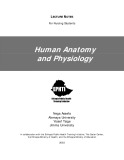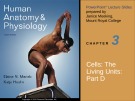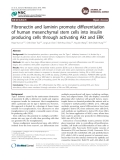
Human anatomy
-
Currently, there are no studies providing data on normal thyroid anatomy images on ultrasound to document thyroid imaging for doctors in the country in general and in the Mekong River Delta in particular. Therefore, it is necessary to determine the size of a normal adult human thyroid gland by ultrasound and contribute to providing reference data for the training of clinicians, especially determining the dose of drugs to treat some thyroid diseases related to the size of the gland.
 7p
7p  vinara
vinara
 11-01-2025
11-01-2025
 3
3
 1
1
 Download
Download
-
Human anatomy and physiology is more than just interesting, it is fascinating. To help get the students and instructions involved in the study of this subject, a number of special features are incorporated throughout the lecture note.
 428p
428p  phannguyenhaminhths
phannguyenhaminhths
 18-08-2021
18-08-2021
 26
26
 2
2
 Download
Download
-
This chapter provides knowledge of cell cycle. The main contents of this chapter include all of the following: List the phases of the cell cycle and describe the key events of each phase, describe the process of DNA replication.
 9p
9p  tangtuy07
tangtuy07
 02-04-2016
02-04-2016
 33
33
 2
2
 Download
Download
-
Background: Pancreatic cancer is one of the most aggressive human tumors due to its high potential of local invasion and metastasis. The aim of this study was to characterize the membrane proteomes of pancreatic ductal adenocarcinoma (PDAC) cells of primary and metastatic origins, and to identify potential target proteins related to metastasis of pancreatic cancer.
 13p
13p  toshiba23
toshiba23
 18-11-2011
18-11-2011
 81
81
 3
3
 Download
Download
-
Islet transplantation provides a promising cure for Type 1 diabetes; however it is limited by a shortage of pancreas donors. Bone marrow-derived multipotent mesenchymal stem cells (MSCs) offer renewable cells for generating insulin-producing cells (IPCs). Methods: We used a four-stage differentiation protocol, containing neuronal differentiation and IPC-conversion stages, and combined with pellet suspension culture to induce IPC differentiation.
 10p
10p  toshiba23
toshiba23
 18-11-2011
18-11-2011
 54
54
 2
2
 Download
Download
-
Giải phẫu học (Anatomy) (xuất xứ từ tiếng Hy Lạp là νατομία anatomia có nghĩa là tách ra, cắt ra) là một nhánh của ngành sinh vật học nghiên cứu về cấu trúc của cơ thể sống. Thuật ngữ này bao gồm giải phẫu học cơ thể người (human anatomy), giải phẫu học động vật (animal anatomy – zootomy), giải phẫu học thực vật (plant anatomy – phytotomy). Ở đây chúng ta chỉ học về giải phẫu học cơ thể người nên sẽ không nói sâu về zootomy và phytotomy. Giải phẫu học cơ thể người là ngành khoa học cơ bản...
 7p
7p  buddy7
buddy7
 29-06-2011
29-06-2011
 142
142
 24
24
 Download
Download
-
Giải phẫu học (Human Anatomy)-khoa học nghiên cứu về hình thái, cấu trúc các cơ quan cơ thể con người. Là khoa học cơ sở y học nói chung và cơ sở ngoại khoa, y học thực nghiệm nói riêng.
 7p
7p  universe2071
universe2071
 15-01-2011
15-01-2011
 385
385
 51
51
 Download
Download
-
Describe the ways in which toxicants interact with cells. • Recognize how the molecular characteristics of toxicants affect entrance into a cell. • Explain human anatomy as related to integumentary, respiratory and digestive systems. • Summarize the routes of toxicant absorption.
 7p
7p  nguyenvanquan037
nguyenvanquan037
 07-01-2011
07-01-2011
 82
82
 6
6
 Download
Download
-
Giải phẫu học người (human anatomy) là môn khoa học nghiên cứu cấu trúc cơ thể con người. Tuỳ thuộc vào phương tiện quan sát, giải phẫu học được chia ra thành 2 phân môn: giải phẫu đại thể (gross anatomy hay macroscopic anatomy) nghiên cứu các cấu trúc có thể quan sát bằng mắt thường; giải phẫu vi thể (microscopic anatomy hay histology) nghiên cứu các cấu trúc nhỏ chỉ có thể quan sát dưới kính hiển vi. Tuy nhiên ở hầu hết các trường đại học y, giải phẫu học chỉ trình bày giải phẫu đại thể...
 5p
5p  ytaxinhdep
ytaxinhdep
 19-10-2010
19-10-2010
 1400
1400
 249
249
 Download
Download
-
Understanding human anatomy will help you achieve greater expressive ability in figure drawing. By understanding the many different aspects of the human form, you can better grasp how the figure works as a whole. For example, if you feel along the bone on the lower part of your jaw, you will notice that there is a small indentation about halfway between the chin and the back of the jaw. This indentation is to allow a blood vessel to pass under the jaw. The indentation helps to protect the vessel. The significance of this little indentation is that it affects the...
 18p
18p  audi123
audi123
 31-07-2010
31-07-2010
 203
203
 51
51
 Download
Download
CHỦ ĐỀ BẠN MUỐN TÌM






















